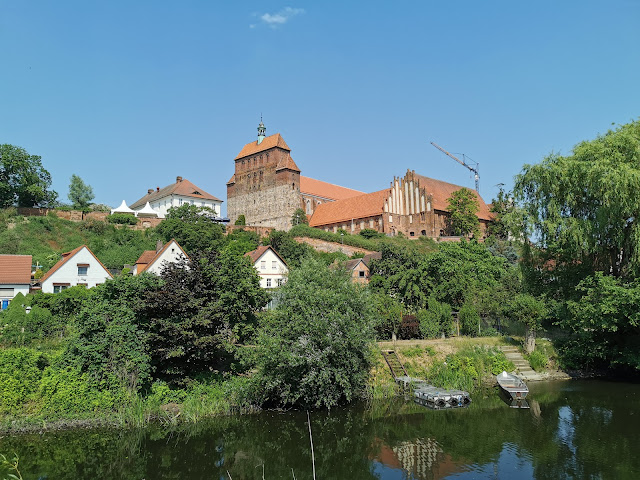On a sunny early June weekend, Ania and I decided to do a day trip and visit a couple of towns west of Berlin. After taking a train and then a bus we reached the first town, Werben, a former member of the Hanseatic League despite its distance from the sea. Being right on the Elbe River meant the town had easy access to the sea and trading with other Hanseatic cities such as Hamburg. Walking through the small old town we first reached the church of St John, originally dating to the 12th century but built in its current brick gothic form between the 14th and 15th centuries. Its interior holds a series of medieval stained glass windows, a beautiful 15th-century Gothic winged altar, a brass baptismal font from 1489, and a baroque organ. After visiting the church we continued our walk passing by some nice examples of timber-framed houses, many of which with roses and other flowers adorning their fronts and facades making them look even prettier. We reached the central and main square, the Markplatz, with low houses and the unassuming small town hall. Behind it was the so-called Salzkirche, formally known as the St. Spiritus chapel, once belonging to the Holy Spirit hospital founded in 1313. Its current appearance took place in the 15th century, and only the apse and half of the building was completed. Right above it was a stork nest with either one of the parents patiently waiting for its partner to bring back food for its chicks. Not too far we walked through the Elbtor, the only remaining of five city gates, built around 1470 in a Gothic style. Next to it was a wooden pole where another pair of storks had made their nest, with their chicks nearly fully grown already. At that point, we decided to walk through the countryside to the next town, Havelberg. We left Werben behind us following a cycling path that eventually took us along the bank of the Elbe River. After some time, we stopped on a small sandy beach by the water where we ate the lunch we had brought along with us. Once done, we continued along the path and eventually reached a point on the river where we were able to take a ferry to cross over to the other side. We had to wait a little while, while some cars were ferried over to our side. Then once on, we paid the pedestrian price, 1 euro 50, and crossed over. On the other side, we walked a little more until we finally reached the town of Havelberg. This too used to belong to the Hanseatic League, being located on the Havel River, right before it joins the Elbe. We first stopped at a modern-looking wooden building, the Haus der Flüsse, which held inside a small museum/information center about the Natura 2000 Middle Elbe Biosphere Reserve. From there we continued on and reached the old town, walking through the pretty streets and alleyways lined by old houses and buildings from different time periods. We reached the parish church of St. Laurentius, built in a Gothic style during the 14th century but it was unfortunately closed. We continued on our walk and then left the little island surrounded by the Havel River, which held the majority of the old town and crossed over to the northern part on the other side of the river. This small part is located partly on a sloping hill over the river, at the top of which stands the Cathedral which we then reached. This beautiful and large building is one the best examples of Romanesque and early Gothic religious buildings in the country, particularly east of the Elbe. It dates to the 12th century and was expanded and refurbished between the 13th and 14th centuries. Its core and nave are Romanesque, with softly rounded arches and thick pillars, while the vaulted ceiling arches, exterior, and striking 30m high Westwork are Gothic. Once inside we marveled at its size and beauty, with a tall, long, and airy main nave, sided by lower minor naves. Particularly noteworthy was the richly decorated rood screen made in sandstone with several figures separating the apse and with a large crucifix hanging above it. Behind it were carved choir stalls from the 14th century, a baroque altar, a Renaissance baptismal font, and the tomb of bishop Johann Wopelitz. Additionally, there were also some nicely made stained glass windows from the 14th and early 15th century. Finally, we finished the visit by walking around the nice cloister, located on the southern side of the cathedral, where they were setting up a stage for a multi-day event to take place in the coming days. After the visit, it was time for us to head back, so we took a bus and eventually reached the town of Glöwen where we then took a train to Berlin from its train station.
 |
| The old town of Werben |
 |
| The interior of the church of St. John |
 |
| The Gothic winged altarpiece |
 |
| A street in the old town |
 |
| View of the Salzkirche |
 |
| The Elbtor |
 |
| The countryside along the way |
 |
| Elbe River bank |
 |
| View of Havelberg |
 |
| A street in the old town |
 |
| The church of St. Laurentius |
 |
| Another street in the old town |
 |
| The Cathedral on top of the hill |
 |
| The Cathedral westwork |
 |
| View of the old town |
 |
| The interior and chancel |
 |
| The presbitery |

















No comments:
Post a Comment